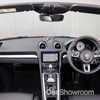The baby drop-top Porsche has gone back to four cylinders, and added 718 to the name, but fans won’t be disappointed with the new 718 Boxster.
There’s no such thing as a cut-price Porsche, although the Boxster comes closest to being affordable, and that it delivers the real Porsche experience is icing on the cake. The manual 718 Boxster 2.0-litre starts at $113,100 plus on roads. The PDK version is $114,433 (plus ORC). Most people will be more than happy with the base model, especially if they add a few well-chosen options. The 718 Boxster S hits the showroom at $143,400 (plus ORC) or $148,390 (plus ORC) with PDK.
In case you haven’t been paying attention, the Boxster has been given a new name, the Porsche 718 (pronounce it “seven-eighteen”, not “seven-one-eight”) Boxster comes with a choice of two four-cylinder turbocharged petrol engines.
But there’s method to this seeming madness. Porsche started out producing lightweight four-cylinder sports cars. And, as Porsche technical expert, Paul Watson, explains, “It’s close to our hearts because lightweight mid-engined sports cars are where we started.”
And that sports car is the Porsche 356 which led a succession of superb four-cylinder Porsches, including the legendary Porsche Spyder 550 and its successor, the 1957 718 RSK. Even when the company moved to the six-cylinder 911 in 1964, there was a four-cylinder model (the 912) in what was essentially the same body. Not quite so close to the hearts of Porsche fans, the 914 and 924 models were also four-cylinder and the last four-pot Porsche offered to the public was the under-rated 968.
The base car (called simply “the 718 Boxster”) gets a 2.0-litre turbocharged petrol engine, horizontally opposed in-keeping with Porsche principles. This engine has a single turbocharger and intercooler and produces 220kW and 380Nm. The 718 Boxster S runs a 2.5-litre four-cylinder petrol engine with a turbocharger that uses variable turbine geometry, something that’s quite common on diesel engines, but according to Paul Watson, unique to Porsche on a petrol-engined production car. The 2.5-litre engine lifts outputs to 257kW and 420Nm. Torque comes on song from just 1900rpm.
The changes to Porsche’s engines have been made inevitable by legislation demands. The 2.0-litre engine drops CO2 emissions by 24g/km over the previous 2.7-litre flat six Boxster. Fuel economy has also improved by 13%. As for power and torque figures, the new Boxsters outdo the previous models by 26kW and a full 100Nm (Boxster) and 60Nm (Boxster S).
Braking is another area where the 718 Boxster has been improved. The base Boxster now gets the brakes that were standard on the previous Boxster S, while the 718 Boxster S uses brakes from the Carrera 911. Also upgraded are suspension and power steering response.
The new Boxster carries over only the bonnet, windscreen and bootlid from the previous model. Everything else is new. The front guards are more steeply angled with sharp crease lines along the tops of the front and rear wings and the front end appears wider, thanks to narrow front lights above lateral air intakes containing parking lights and indicators. In the centre, two horizontal fins emphasise the width. LED headlights with four-point daytime running lights (cost optional) are a model signature. In profile, the Boxster has new wings and sills and two large air intakes forward of the rear axle to supply both engine and intercooler with air.
The 718 Boxster comes with 18-inch alloy wheels as standard (with 19s cost optional), while the S gets the 19s as standard and the option of 20-inch wheels. Most obvious (and pleasing) styling changes have been made at the rear with a stylish accent strip with integrated Porsche nameplate running across between the tail lights which have been completely redesigned. Tail lights get three-dimensional LED technology and four-point brake lights. It’s an impressive piece of design, but when following other Boxsters, we found it quite difficult to see the rear indicators when the brake lights were also lit.
Hopping into the Boxster cockpit brings no real surprises for anyone who has recently been inside any other Porsche. It’s stylish without being over-styled, and to some tastes may appear a little understated, but as always, immaculately finished. The dashboard has been redesigned, although it still follows the traditional Porsche layout of having the tacho directly in front of the driver.
The steering wheel is 375mm in diameter and echoes the design of that found in the 918 Spyder.
A real advance for Porsche is the PCM (Porsche Communication Management) system in the 718 Boxster. It incorporates easy-to-operate mobile phone integration (even I managed to sync my phone without drama), audio interfaces and a 100-watt sound package. Extra modules can be specified to personalise it further, such as the Connect module that comprises a smartphone storage tray for wireless connection of the phone to the car’s exterior antenna, an iPod-capable USB port on the centre console, Apple Car Play (including Siri voice control) and Porsche Car Connect. Also optional is the navigation module with voice control for simplified input of driving destinations. Map updates are free for the first three years.
Unlike the 911, the Boxster is mid-engined, making it sublimely well-balanced and agile. The first thing you notice on taking to the road is that these new 718 Boxsters are significantly faster than the models they replace. The considerable increase in torque transforms the response of the cars and mid-range overtaking becomes a real pleasure. When the engine revs rise above 2000, the turbo comes alive and the urge continues all the way to 7500rpm.
The 718 Boxster S, with its extra power and torque feels even more willing although whether the extra performance justifies the additional cost is a decision best left to the buyer. The changes to suspension and steering (the rack is 10% quicker) have made the Boxster even better than before, with a level of poise its still excellent predecessor couldn’t match, and a quite different feel and driving experience than is to be found in a 911.
The choice between six-speed manual or optional paddle shift PDK will come down to personal choice. The manual is a delight to use, with a light and communicative clutch, but the PDK is quicker and more economical on fuel.
However, it’s not all good news. The previous six-cylinder engine had a glorious soundtrack that the new four-cylinder simply can’t match. Sure, in Sport mode, the engine gets a more distinct growl and some tingly cracks and pops on the over-run, but generally, the engine note is oddly uninvolving and even, on occasion, almost lumpily unbalanced.
The engines are both brilliantly flexible, pulling happily from low revs (try nailing the throttle as you come out of a 60km/h zone in fifth gear). As you start to travel faster, the absence of two cylinders becomes less obvious than at idle. When you roll off the accelerator and fuel is cut to the injectors, the throttle actually stays open to pre-condition the turbo for immediate response when you reapply your foot to the GO pedal.
Understeer is virtually non-existent on the road (unlike on a skid pan, where we attempted some drifting, at the local launch, on a water- and diesel-soaked skid pan, and quickly discovered how wide the nose will push if you come into a corner too fast – but this is totally unlike almost anything you will ever experience in everyday driving). The revised electric steering is excellent and in conjunction with the balance and the seat-of-the-pants feedback, always keeps you in touch and involved with what’s happening under the wheels.
Grip is prodigious, especially in the dry and acceleration is seriously quick: the 718 Boxster with PRK and Sport Chrono package hits 100km/h in 4.7 seconds. A similarly equipped Boxster S does it in 4.2 seconds. Top speed of the Boxster is 275km/h while the S is 10km/h faster at 285km/h.
Fuel consumption isn’t quite so clear cut. Porsche’s claimed figure for the 2.0-litre Boxster with PDK is 6.9L/100km and the PDK 2.5-litre model achieves 7.3L/100km. We covered 150km in a PDK Boxster S and a further 150km in a manual Boxster. The S was showing fuel consumption of 11.5L/100km at the end, although to be fair, we had been driving “spiritedly”. The manual 2-litre Boxster showed exactly the same 11.5L/100km after our drive through some challenging roads, but this came down to 10.8L/100km after a calm 50km freeway and highway run to the airport.
Had there never been a six-cylinder Boxster, the 718 would be receiving almost unstinting and well-deserved praise. However, to meet changing demands, some compromises need to be made. To make the new Boxster meet emissions and fuel consumption targets, and meet the demands of buyers to be faster, the only way forward is fewer cylinders and turbocharging. By any measure, the new 718 Boxster is one of the sweetest sports cars currently available.
For more on Porsche vehicles, including pricing and specifications, check out our Showroom.






























